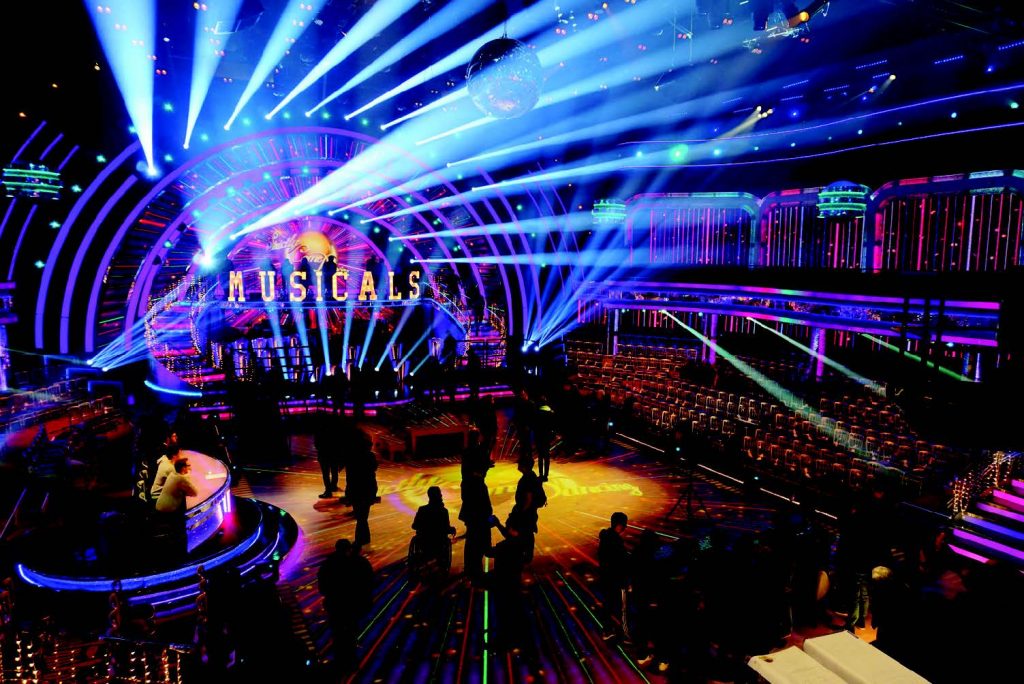Teodora Lyubomirova reports from Elstree Studios on an STLD-organised student meeting with key members of Strictly Come Dancing’s lighting team…
[UK] If it ain’t broke, don’t fix it, right? Except even Britain’s favourite dance competition needs an occasional spruce-up. With Sarah James taking on the Glitterball baton as Strictly Come Dancing’s new executive producer for BBC Studios, the 2019 show was on course for change.
“I always thought they had to get rid of me, so to speak,” says David Bishop, Strictly’s new lighting designer, who has taken over from Mark Kenyon having proved his worth after seven years as an operator. “Because of the speed I had to work at and the length of time I’d been doing the show, I had done everything I could think of with the lighting design as it stood.” Bishop was speaking during a backstage tour of the George Lucas Studio, part of the BBC’s Elstree Studios and the home of the 360° ballroom set.
Following a reception sponsored by lighting manufacturer Vari-Lite, the main event was organised by the Society of Television Lighting Designers (STLD) to benefit entertainment technology students, who aspire to finding a career in TV lighting. Attending were around 70 students from across Backstage Academy, Central School of Speech and Drama, the Guildford School of Acting, Rose Bruford College and the Royal Academy of Dramatic Art. STLD chairman, Bernie Davis, explains: “The STLD is trying to build on the assistance we can give to students wanting to get into TV lighting, and this event is just one thing. We are also in conversation with some of the training establishments with the aim of advising what students ought to include in their training if heading for a career in TV, and then we hope we can act as a catalyst to getting placements and shadowing experience.” On this occasion, it was all about getting insight into the inner workings of Strictly straight from the show’s key crew members – LD Bishop and operators Darren Lovell, Tom Young and Matt Lee.
Lovell – who controls the followspots and backspots, along with a selection of automated and conventional fixtures used to illuminate the performers and presenters – has worked on the show since its first season in 2004. However, this was the first Strictly for Young (moving lights/ colour-changing luminaires) and Lee (video and graphics). This was also the first time three operators have been involved instead of two – “and the reason why the show looks so polished is because they’ve had time to work on their individual areas,” as Bishop explains. He continues: “The budget hasn’t increased for many years, but the support of rental houses and manufacturers has been incredible, we’ve got nearly 700 moving lights in here. The changes that I’ve made this year are not always flashy.” Said changes include adding more colour mixing luminaires. Up in the arches, there are around 40 Robe MegaPointe fixtures, which are backedup with Claypaky B-Eye K10s for wash, beam and effects. Lining the two long sides of the rectangular dance floor are GLP impression X4 Bar 20s, providing more effects and cross-light during the group numbers. In between these and elsewhere on the floor are Ayrton Mistrals, another colourmixing luminaire picked for its neat housing.
Shot in 360°, the production uses an 11-camera set-up, including a 30ft MovieBird Techocrane, four Pedestals, a radio Steadicam and four tripod cameras. The immersive effect is further reinforced thanks to the video screens on the four sides of the studio and through 3D graphics projected on the dance floor and designed by Potion Pictures’ David Newton. “We are very fortunate that our spot team are really experienced in TV but also come from a theatre background,” continues Bishop. “They understand what we try to achieve, both with the performers and whilst working with the cameras. It’s also about operating as tight as possible in order to show the projection on
the floor.”
Would an LED floor be introduced? “The production team is constantly looking to improve the show, and this includes the dancefloor,” says Bishop. “There’s a big drive towards installing a fully-sprung dancefloor for many reasons, but it’s some way off yet. It’s highly unlikely we’d find a sprung floor with an integrated LED product. That’s why we are still using six Panasonic DS20K HD projectors.”
Read Full Article Here.Control-wise, Lovell operates a Compulite Vector; Lee, also the Hippotizer media server operator, is handling graphics on a High End Systems Full Boar 4, and Young is using grandMA3 with MA2 software.
Article & Image Credit: LSi Online
Event credit: www.stld.org.uk & www.davidbishop.com
